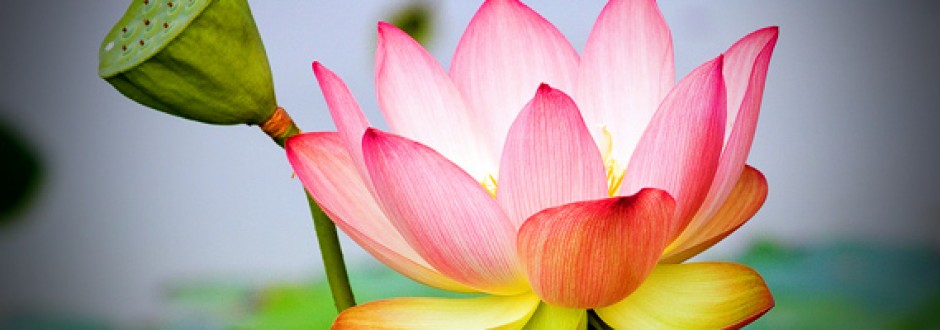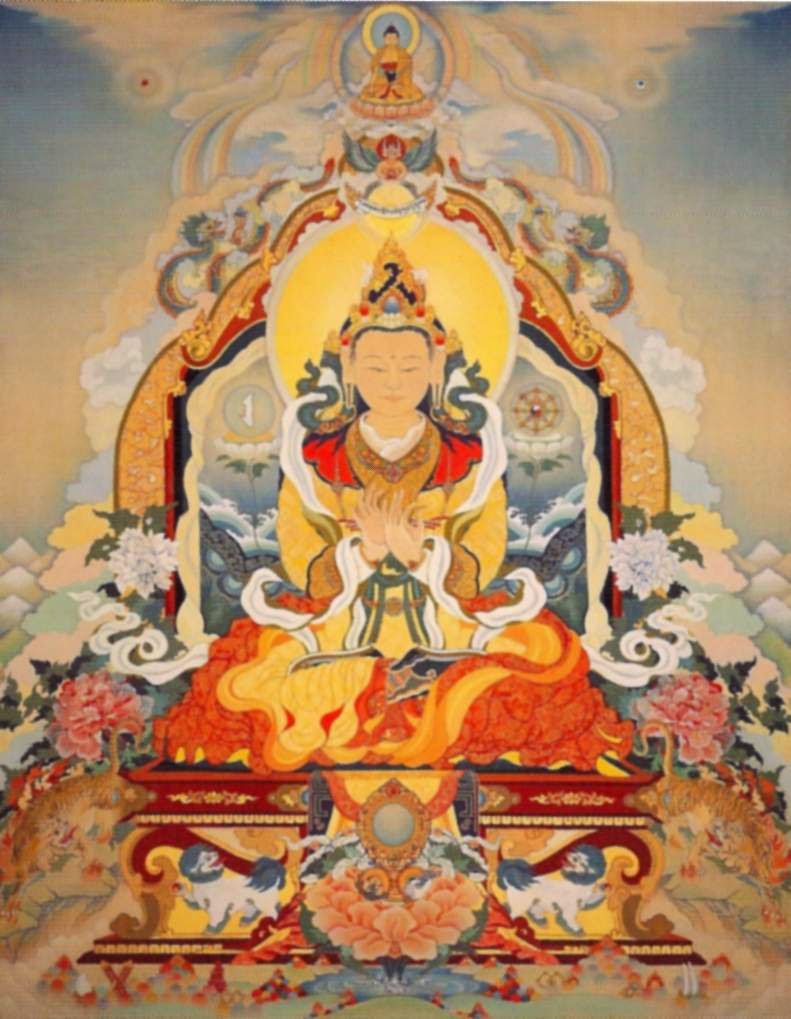Now, as Gesar and his warriors traversed the high mountains and plains, it was as if they were traveling in a magic land. Gesar sang to them, recounting the lineage of the Rulers of the Kingdom of Shambhala, the enlightened pure land that is far to the North. He began with some more verses from the miraculous Avatamsaka sutra:
The Mind-King Jewel
Appears in different colors to different minds,
But when a mind is unclouded by hope and fear,
The pure lands can be clearly seen.
Like great Dragon Kings
Creating clouds that fill the sky,
The power of an enlightened ruler’s vow
Brings joy and virtue to his land.
With these verses he began this long song.

The Earth Protector Kings
Who ruled the land called Shambhala,
Which means “Held by the Source of Happiness”,
Were all descended from Shambhaka of the Sakya clan,
Emerging from this immemorial lineage,
Suchandra, Auspicious Moon, the Lord of Secrets,
Is the first to be called a Dharma King.
Now he enters the Crystal Hall of the Kalapa Court.
This great Dharma Raja enters this world as an emanation of Vajrapani,
The All-Conquering Lord of Secrets,
Who brings the blazing light of wisdom
Into the fickle realities of the human realm.
Vajrapani is the master of Buddha Activity
Beyond the waxing and waning of life and death.
Out of Vajrapani’s heart, the Dharma King Suchandra takes birth
As the first son of King Suryaprabha and Queen Vijaya.
Thus he enters the Kalapa Court and takes his seat on the Lion Throne.
His pale face is serene and his dark gaze fathomless.
His hair and mustache are black and smooth.
He wears the Gold Crown of Reality Beyond the Limit of Knowledge
Which is surmounted by a white diamond free of any flaw.
As the lord of heart and mind,
He wears gold earrings shaped like sea-dragons.
His dragon-patterned brocade robe is turquoise.
His sash is pale red like an early winter moon.
In his right hand he holds a white lotus
On which stands a crystal Vajra;
In his left a silver bell.
He sits on a glowing golden throne
Beneath the rainbow-colored parasol of complete fearlessness
Which is vast as the sky and supported by a golden pole high as Mount Meru.
Encountering him is overwhelming
As if one had emerged in the night from a narrow mountain pass
And found oneself suddenly on an immense plain bathed in full moonlight.
![]()
In his unchanging secret form, the Great Dharma King Suchandra
Is ever youthful and his body is white as a conch.
His face is inviting and completely peaceful.
Because he has attained the summit of dharma,
His top-knot is surmounted by the three jewels
Blazing with their own radiance.
He wears the flower garland crown of the five senses
And a necklace of the five elements displayed as five kinds of gem-stones.
He wears a red and gold brocade shawl as radiant as the splendor of love.
His golden bracelets are the four aims of life.
He wears the Jewel Treasure of the Ocean on a gold chain at his heart.
In his right hand, he holds the Wish Fulfilling Tree,
And in his left a red lotus,
On which stands the golden eight-spoked wheel of unobstructed truth
Surmounted by the three jewels.
His consort on his right, gold as the dawn sun,
Makes the gesture of timeless offering,
Extending the gold vase of eternal life surmounted by the flaming three jewels.
The Dharma King Suchandra is surrounded
By all the offerings of the phenomenal world.
In the peace of his radiance, there is no room for doubt or discursiveness.
![]()
The Great Dharma Raja Suchandra journeyed to the stupa of Dhyanakataka,
Accompanied by a great retinue of Nagas, Dralas,
And a vast number of his own subjects.
There the Great Lord prostrated to the Enlightened One,
Sage of the Sakyas, the Gautama Buddha,
The conqueror of the three worlds and light of this age.
The Dharma Raja requested the teachings for one who remains a King,
Remains in the embrace of the senses, and seeks the well-being of all.
He requested the teachings that unfold outer life as an inner path.
He requested the teachings that open the gate of the seventh consciousness,
And purify the full display of the ayatanas.
He requested the teachings that show the world of Basic Goodness
Glowing and fertile in the light of the Great Eastern Sun.
According to the text of The Supreme First Buddha,
The way in which he made his request is told as follows:
To eliminate the kleshas of sentient beings
By the union of body, speech and mind,
He supplicated the Bhagavan by offerings
Of jewel flowers strewn at his lotus feet.
He supplicated with the petals of precious flowers,
With prostrations made on bended knee.
With right knee to the floor
And with palms joined at the forehead,
The Lord of Shambhala requested:
“The Unsurpassed Highest Tantra, The First Buddha
Gathers all siddhis, possesses the vowels and consonants,
The Glorious Yoga of Kalachakra
Instantly manifests perfect Buddhahood.
“Possessing the four times
By its 60 divisions,
It holds the four bindus:
The emptiness and wisdom bindu,
The great supreme Vajra Holder,
The great emptiness of five words,
The empty bindu of six letters.
“Outer, body, Buddha, god, and non-god, 25 classes of beings,
All are within the nature
With bodies of various scale
Which are the cause of the three worlds’ arising,
The enjoyment of gods and non-gods;
All these without exception
I ask the teacher to explain.”
The interior of the stupa was transformed into an immeasurable skull cup,
The inconceivable expanse of the dharmadhatu.
There, in the infinite expanse without beginning or end,
The Buddha arose in the form of Vajrasattva
And opened the mandala of Kalachakra, The Lord of Time.
In the great dance of Vajra compassion,
He opened the immeasurable palace:
Below, he displayed the twelve blissful aspects
Of the Lord of Vajradhatu Speech;
Above, he displayed the sixteen mandalas of stars.
All this had not been seen, heard or known
Since the eon of Buddha Dipankara.
In this way, the Buddha himself gave the initiation
Into the great Mandala of Vajradhatu
And conveyed the root text of the Tantra of Glorious Kalachakra.
The Root Tantra explains the essence:
Ka is pacification of cause.
La is dissolving.
Cha is the motion of mind.
Kra is being bound to the stages.
And the Great Commentary expands this:
Whoever has neither cause nor characteristics,
Is without movement and free from stages:
This is the meaning of Kalachakra.
To that non-duality, I make homage.
So upon returning to Shambhala, Dharma Raja Suchandra
Recorded all this in writing, the “Paramadibuddha” in 12,000 verses,
With commentary five times that length.
Upon returning to Kalapa,
Dharma King Suchandra manifested his pure perception
As a great pleasure garden
To the south of the Palace of Kalapa and to the West of the “Near Lake”.
In the midst of that vast park called Malaya,
From liquid gold, rubies, sapphires, emeralds,
Crystal, coral, and turquoise and silver,
The Dharma Lord built the great Body Mandala of the Lord of Time,
A perfect square with four gates, four arches and eight charnel grounds
With five surrounding fences,
And beyond them the mandala of the elements adorned with vajra chains.
Near it he built the Speech Mandala of Kalachakra, alike in form,
And close to that, he built the Mind Mandala of Kalachakra,
Alike in form but with three surrounding fences.
Closer still, he placed the Wisdom Mandala of Kalachakra
Surrounded by sixteen jeweled towers.
Again nearest yet to the Kalapa Court, the Dharma King Suchandra
Created a vast eight-petalled lotus
Whose golden anthers sway on breezes of delight and brush the sky,
Radiating like a hundred suns.
Placed in the timeless expanse of pure perception
The Mandalas of the Lord of Time are utterly complete
In every aspect and characteristic and power.
From this moment on, time is marked with the names of the Kings of Kalapa.
It is from this time that the names of the Lords of Kalapa are known to all.
It is from this time that the teachings of Shambhala flourish,
Blazing through all the human realm and in every human heart.
This was extracted from The Brilliance of Naked Mind: Secret Visions of Gesar, King of Ling with the kind permission of the author Douglas J. Penick.
Featured image of King Suchandra of Shambhala
